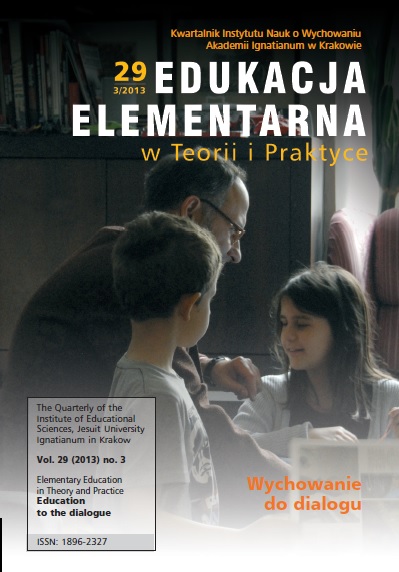Komunikacja małżeńska kluczem wychowania do dialogu – sprawozdanie z badań
Abstrakt
Rozumienie funkcjonowania rodziny zależy w dużej mierze od znajomości zmian, jakie zachodzą w diadzie małżeńskiej. Przemiany te widoczne są najbardziej na poziomie komunikacyjnym. Na jakość komunikacji małżeńskiej wpływa wiele czynników, m.in. etap życia małżeńsko-rodzinnego, na jakim znajduje się para. Inaczej będzie wyglądało porozumiewanie się małżonków zaraz po ślubie, inaczej z dziećmi małymi, jeszcze inaczej z nastolatkami i po opuszczeniu przez nich domu rodzinnego. Przeprowadzone na potrzeby niniejszej pracy badania miały na celu pokazanie jakości komunikacji małżeńskiej (złożonej z trzech wymiarów: wsparcia, zaangażowania i deprecjacji) na poszczególnych etapach życia małżeńsko-rodzinnego. Na podstawie dostępnej literatury przedmiotu wyodrębniono sześć następujących faz życia rodziny: małżeństwo bez dzieci, małżeństwo z małymi dziećmi i dziećmi w wieku przedszkolnym, małżeństwo z dziećmi w wieku szkolnym, małżeństwo z nastolatkami, małżeństwo z dziećmi opuszczającymi dom oraz małżeństwo dojrzałe. Badania potwierdziły założenie, że komunikacja małżeńska w trakcie trwania związku zmienia się, a jej jakość się pogarsza. W początkowych fazach małżonkowie osiągają dobre wyniki we wszystkich trzech wymiarach komunikacyjnych: wykazują wysoki poziom wsparcia i zaangażowania, przy niskim poziomie deprecjacji. Z czasem proporcje odwracają się – obniża się jakość wsparcia i zaangażowania, a wzrasta deprecjacja. Znajomość przemian komunikacyjnych w związku małżeńskim może pozwolić wychowawcy przedszkolnemu na lepsze rozumienie problemów zachodzących w rodzinie na poszczególnych etapach jej życia, zwiększając tym samym możliwości pomocy w przeżywanych trudnościach.Bibliografia
Adamski F., Duchowość życia małżeńsko-rodzinnego, [w:] Miłość, małżeństwo, rodzina, red. F. Adamski, WAM, Kraków 1981.
Baniak J., Znaczenie dialogu w małżeństwie, „Małżeństwo i Rodzi- na”, 9(2004)1.
Braun-Gałkowska M., Miłość aktywna, PAX, Warszawa 1980.
Braun-Gałkowska M., Psychologia domowa. Małżeństwo, dzieci, rodzina, Warmińskie Wydawnictwo Diecezjalne, Olsztyn 1987.
Cader S., Wychowawczy wymiar dialogu małżeńskiego, „Pedagogika Rodziny: opieka i wychowanie we współczesnej rodzinie”, 2(2007), nr 1.
Celmer Z., Małżeństwo, Państwowy Zakład Wydawnictw Lekarskich, Warszawa 1989.
Czekalski R., Katecheza komunikacją wiary, Płocki Instytut Wydaw- niczy, Płock 2006.
Dobek-Ostrowska B., Podstawy komunikowania społecznego, Astrum, Wrocław 2004.
Domachowski W., Interakcyjny model funkcjonowania społecznego, [w:] Społeczna psychologia kliniczna, red. H. Sęk, PWN, Warszawa 1998.
Frydrychowicz S., Komunikacja interpersonalna w rodzinie a rozwój indywidualny, [w:] Rodzina a rozwój człowieka dorosłego, red. B. Harwas-Napierała, Wydawnictwo Naukowe UAM, Poznań 2003.
Frydrychowicz S., Proces mówienia, Wydawnictwo Naukowe UAM, Poznań 1999.
Grygielski M., Style komunikacji rodzicielskiej a identyfikacja dzieci z rodzicami, Towarzystwo Naukowe KUL, Lublin 1999.
Harwas-Napierała B., Komunikacja interpersonalna i jej kształtowanie jako istotny wymiar jakości życia rodziny, [w:] Jakość życia rodzinnego. Wybrane zagadnienia, red. T. Rostowska, Wyższa Szkoła Informatyki, Łódź 2006.
Harwas-Napierała B., Komunikacja interpersonalna w rodzinie, Wydawnictwo Naukowe UAM, Poznań 2006.
Harwas-Napierała, Zmiany komunikacji w poszczególnych fazach małżeństwa, „Psychologia Rozwojowa”, 11(2006)4.
Namysłowska I., Terapia rodzin, Springer PWN, Warszawa 2000.
Ostoja-Zawadzka K., Cykl życia rodzinnego, [w:] Wprowadzenie do systemowego rozumienia rodziny, red. B. de Barbaro, Collegium Medi- cum UJ, Kraków 1997.
Plopa M., Psychologia rodziny: teoria i badania, Wydawnictwo El- bląskiej Uczelni Humanistyczno-Ekonomicznej, Elbląg 2004.
Plopa M., Więzi w małżeństwie i rodzinie: metody badań, Impuls, Kraków 2005.
Reber A. S., Dictionary of psychology, Penguin Books, London 1985.
Ryś M., Psychologia małżeńska w zarysie, CMPPP MEN, Warszawa 1999.
Stewart J., Komunikacja interpersonalna: kontakt między osobami, [w:] Mosty zamiast murów, red. J. Stewart, PWN, Warszawa 2000.
Trokan J., Stages of the marital and family Life Cycle: Marital Miracles, “Pastoral Psychology”, 46(1998)4.
Tyszka Z., Socjologia rodziny, PWN, Warszawa 1974.
Wojciszke B., Psychologia miłości. Intymność, namiętność, zobowiązanie, GWP, Gdańsk 2010.
Ziemska M., Rodzina a osobowość, PAX, Warszawa 1975.
Ziemska M., Zmiany w relacjach małżeńskich w cyklu życia rodziny, [w:] Rodzina współczesna, red. M. Ziemska, Wydawnictwo Uniwersytetu Warszawskiego, Warszawa 2001.
Copyright (c) 2013 Edukacja Elementarna w Teorii i Praktyce

Utwór dostępny jest na licencji Creative Commons Uznanie autorstwa – Bez utworów zależnych 4.0 Międzynarodowe.
1. Autor zgłaszając swój artykuł oświadcza, że jest Autorem artykułu (zwanego dalej Utworem) i:
- przysługują mu wyłączne i nieograniczone prawa autorskie do Utworu,
- jest uprawniony/a do rozporządzania prawami autorskimi do Utworu.
Oświadcza, że nie narusza praw autorskich osób trzecich i praw prawnych.
Oświadcza, że nie występuje żaden konflikt interesów.
2. Udziela Uniwersytetowi Ignatianum w Krakowie nieodpłatnej, niewyłącznej, nieograniczonej terytorialnie licencji do korzystania z Utworu na następujących polach eksploatacji:
- utrwalania utworu w formie papierowej, a także na nośniku cyfrowym lub magnetycznym;
- zwielokrotnienia utworu dowolną techniką, bez ograniczenia ilości wydań i liczby egzemplarzy;
- rozpowszechniania utworu i jego zwielokrotnionych egzemplarzy na jakimkolwiek nośniku, w tym wprowadzenia do obrotu, sprzedaży, użyczenia, najmu;
- wprowadzenia utworu do pamięci komputera;
- rozpowszechniania utworu w sieciach informatycznych, w tym w sieci Internet;
- publicznego wykonania, wystawienia, wyświetlenia, odtworzenia oraz nadawania i reemitowania, a także publicznego udostępniania utworu w taki sposób, aby każdy mógł mieć do niego dostęp w miejscu i czasie przez siebie wybranym;
- w zakresie praw zależnych do Utworu, obejmujących w szczególności prawo do dokonania koniecznych zmian w Utworze, wynikających z opracowania redakcyjnego i metodycznego, a także do dokonania tłumaczenia Utworu na języki obce.
Udzielenie licencji następuje z chwilą przekazania Utworu na rzecz Uniwersytetowi Ignatianum w Krakowie. Uniwersytet Ignatianum w Krakowie jest uprawniony do udzielania dalszych sublicencji do Utworu, w zakresie udzielonego prawa. Licencja jest ograniczona czasowo i zostaje udzielona na okres 15 lat, licząc od daty jej udzielenia.
Wyraża się zgodę i zachęca autorów do publikacji ich tekstu w Internecie (np. w repozytorium instytucji lub na jej stronie internetowej) przed lub podczas procesu składania tekstu jako, że może to prowadzić do korzystnych wymian oraz wcześniejszego i większego cytowania opublikowanego tekstu (Patrz The Effect of Open Access). Zalecamy wykorzystanie dowolnego portalu stowarzyszeń badawczych z niżej wymienionych:




